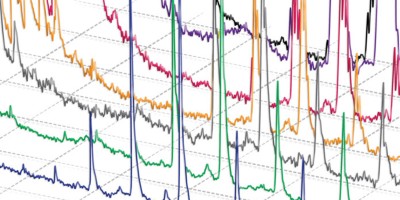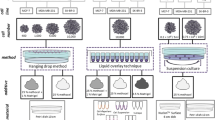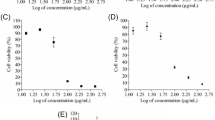Abstract
Our laboratory has refined the technique for isolating primary cultures of normal human ovarian surface epithelial (OSE) cells by combining two different protocols involving the enzymatic and mechanical removal of OSE cells from ovarian biopsies. A simple protocol of obtaining primary epithelial ovarian cancer (EOC) cells from the ascites fluid removed from patients with high-grade ovarian cancer is also described. These methods allow for the direct application of many molecular and cellular analyses of normal versus cancer cells isolated freshly from patients, with the added potential for retrospective analyses of archived cells and tissues. Thus, we have included optional steps for the immediate preparation of ascites-derived EOC cells to be used for subsequent cytological analyses. Initial isolation of OSE or EOC cells can be completed in 1 h, and primary cells are further expanded in culture for several weeks.



Similar content being viewed by others
Change history
05 August 2015
In the version of this article initially published, in the Reagent Setup section, it was stated that 50% v/v Percoll should be made by diluting Percoll in 10× PBS at a 1:1 v/v ratio. Percoll should, in fact, be diluted in 2× PBS at a 1:1 ratio. The error has been corrected in the HTML and PDF versions of the article.
References
Auersperg, N., Wong, A.S., Choi, K.C., Kang, S.K. & Leung, P.C. Ovarian surface epithelium: biology, endocrinology, and pathology. Endocr. Rev. 22, 255–288 (2001).
Murdoch, W.J. & McDonnel, A.C. Roles of the ovarian surface epithelium in ovulation and carcinogenesis. Reproduction 123, 743–750 (2002).
Wong, A.S. & Auersperg, N. Ovarian surface epithelium: family history and early events in ovarian cancer. Reprod. Biol. Endocrinol. 1, 70 (2003).
Dunfield, L.D., Shepherd, T.G. & Nachtigal, M.W. Primary culture and mRNA analysis of human ovarian cells. Biol. Proced. Online 4, 55–61 (2002).
Fu, Y., Campbell, E.J., Shepherd, T.G. & Nachtigal, M.W. Epigenetic regulation of proprotein convertase PACE4 gene expression in human ovarian cancer cells. Mol. Cancer Res. 1, 569–576 (2003).
Matei, D. et al. Gene expression in epithelial ovarian carcinoma. Oncogene 21, 6289–6298 (2002).
Shepherd, T.G. & Nachtigal, M.W. Identification of a putative autocrine bone morphogenetic protein-signaling pathway in human ovarian surface epithelium and ovarian cancer cells. Endocrinology 144, 3306–3314 (2003).
Auersperg, N. et al. E-cadherin induces mesenchymal-to-epithelial transition in human ovarian surface epithelium. Proc. Natl Acad. Sci. USA 96, 6249–6254 (1999).
Auersperg, N., Maines-Bandiera, S.L., Dyck, H.G. & Kruk, P.A. Characterization of cultured human ovarian surface epithelial cells: phenotypic plasticity and premalignant changes. Lab. Invest. 71, 510–518 (1994).
Kruk, P.A., Maines-Bandiera, S.L. & Auersperg, N. A simplified method to culture human ovarian surface epithelium. Lab. Invest. 63, 132–136 (1990).
Hirte, H.W., Clark, D.A., Mazurka, J., O'Connell, G. & Rusthoven, J. A rapid and simple method for the purification of tumor cells from ascitic fluid of ovarian carcinoma. Gynecol. Oncol. 44, 223–226 (1992).
Evangelou, A., Jindal, S.K., Brown, T.J. & Letarte, M. Down-regulation of transforming growth factor beta receptors by androgen in ovarian cancer cells. Cancer Res. 60, 929–935 (2000).
Salamanca, C.M., Maines-Bandiera, S.L., Leung, P.C., Hu, Y.L. & Auersperg, N. Effects of epidermal growth factor/hydrocortisone on the growth and differentiation of human ovarian surface epithelium. J. Soc. Gynecol. Investig. 11, 241–251 (2004).
Ueda, J., Iwata, T., Ono, M. & Takahashi, M. Comparison of three cytologic preparation methods and immunocytochemistries to distinguish adenocarcinoma cells from reactive mesothelial cells in serous effusion. Diagn. Cytopathol. 34, 6–10 (2005).
Acknowledgements
This work was supported by the National Cancer Institute of Canada with funds from the Canadian Cancer Society Grant No. 15303. T.G.S. is supported by a fellowship from the NCIC with funds from the Terry Fox Foundation. B.T. is supported by a fellowship from the Nova Scotia Health Research Foundation. M.W.N. is a Canadian Cancer Society Scientist of the NCIC.
Author information
Authors and Affiliations
Corresponding author
Ethics declarations
Competing interests
The authors declare no competing financial interests.
Rights and permissions
About this article
Cite this article
Shepherd, T., Thériault, B., Campbell, E. et al. Primary culture of ovarian surface epithelial cells and ascites-derived ovarian cancer cells from patients. Nat Protoc 1, 2643–2649 (2006). https://doi.org/10.1038/nprot.2006.328
Published:
Issue Date:
DOI: https://doi.org/10.1038/nprot.2006.328
- Springer Nature Limited
This article is cited by
-
Bromodomain inhibitor i-BET858 triggers a unique transcriptional response coupled to enhanced DNA damage, cell cycle arrest and apoptosis in high-grade ovarian carcinoma cells
Clinical Epigenetics (2023)
-
Ascitic autotaxin as a potential prognostic, diagnostic, and therapeutic target for epithelial ovarian cancer
British Journal of Cancer (2023)
-
The DDUP protein encoded by the DNA damage-induced CTBP1-DT lncRNA confers cisplatin resistance in ovarian cancer
Cell Death & Disease (2023)
-
Splicing factor BUD31 promotes ovarian cancer progression through sustaining the expression of anti-apoptotic BCL2L12
Nature Communications (2022)
-
Loss of hexokinase 1 sensitizes ovarian cancer to high-dose metformin
Cancer & Metabolism (2021)





